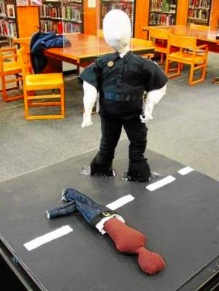As demonstrations in support of free speech were held in Paris and we all reconfirmed our commitment to an open exchange of ideas, two cultural spaces in the United States-– one a library, the other a university-– censored artwork.
First there was the removal of part of Lethia Cobbs’ “Dollandia” installation at the Long Beach Public Library in California, and then the cover-up of parts of Cory Oberndorfer’s mural “Bitter/Sweet” at American University. Both institutions wound up reversing their decisions, but what will happen with future work? Will potentially controversial work be shunned, or will artists be able to share their vision with the public?
As soon as Lethia Cobbs installed “Dollandia,” one piece — which shows a white police officer pointing his fingers as a gun at a black armless doll lying on the ground–prompted an immediate response. The library staffer in charge of art exhibits asked her to remove that doll from the collection because it was “too controversial“(ironically, the artist was told to be “edgy”). Cobbs intention was to show the horrific shootings of black men by police officers-–one of the most topical issues these days, especially salient during Black History Month.
Long Beach later reversed the decision to remove the doll. City spokeswoman Kerry Gerot explained that the artwork hadn’t gone through the normal procedure for approval, and that “that this exhibit was installed and modified by one individual without the knowledge or approval of superiors.” The library is currently considering the future of its exhibitions program.
The mural “Bitter/Sweet” by D.C. painter Oberndorfer represented familiar Valentine’s Day candy hearts with language culled from an internet survey about love, relationships and heartbreak. One of the phrases–presumably from the latter category– was “I don’t fucking care.” And that was considered unacceptable; administrators asked Oberndorfer to either remove the whole piece or remove the F-word. The artist opted for a black censor bar. An official statement from American University was that the work was appearing in a space used for public events. Yet, days later, AU reconsidered and the work was restored. “American University will not censor art,” read the new statement, which nonetheless stressed that
As much as our goal is to preserve and share the vision of artists, we must also consider the young students, children, parents, and all members of the community who grace our halls throughout the day.
The challenge for administrators in both instances is the lack of a clear policy. The censorship of the artists’ work occurred as a consequence of the confusion of whether or not potentially controversial art has a place in a library or university. Both cases call out for the need for policies that embrace the right to artistic freedom of expression, including the right to exhibit controversial art. An avoidance of controversial subject matter not only potentially leads to First Amendment problems, it presents an impoverished version of art and, consequently, an impoverished public sphere.



